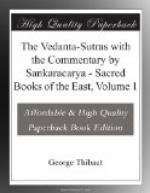capable (of complying with the precepts of the
sastra);
are, secondly, desirous (of the results of actions
enjoined by the
sastra); are, thirdly, not
excluded by prohibitions; and are, fourthly, subject
to the precepts about the upanayana ceremony and so
on[193]. This point has been explained in the
section treating of the definition of adhikara (Purva
Mim. S. VI, 1).—Now the human body
has ordinarily a fixed size, and hence the heart also
has a fixed size,
viz. the size of a thumb.
Hence, as men (only) are entitled to study and practise
the
sastra, the highest Self may, with reference
to its dwelling in the human heart, be spoken of as
being of the size of a thumb.—In reply to
the purvapakshin’s reasoning that on account
of the statement of size and on account of Sm/ri/ti
we can understand by him who is of the size of a thumb
the transmigrating soul only, we remark that—analogously
to such passages as ‘That is the Self,’
’That art thou’—our passage
teaches that the transmigrating soul which is of the
size of a thumb is (in reality) Brahman. For
the Vedanta-passages have a twofold purport; some
of them aim at setting forth the nature of the highest
Self, some at teaching the unity of the individual
soul with the highest Self. Our passage teaches
the unity of the individual soul with the highest Self,
not the size of anything. This point is made clear
further on in the Upanishad, ’The person of
the size of a thumb, the inner Self, is always settled
in the heart of men. Let a man draw that Self
forth from his body with steadiness, as one draws
the pith from a reed. Let him know that Self
as the Bright, as the Immortal’ (II, 6, 17).
26. Also (beings) above them, (viz. men) (are
qualified for the study and practice of the Veda),
on account of the possibility (of it), according to
Badaraya/n/a.
It has been said above that the passage about him
who is of the size of a thumb has reference to the
human heart, because men are entitled to study and
act according to the sastra. This gives
us an occasion for the following discussion.—It
is true that the sastra entitles men, but,
at the same time, there is no exclusive rule entitling
men only to the knowledge of Brahman; the teacher,
Badaraya/n/a, rather thinks that the sastra
entitles those (classes of beings) also which are above
men, viz. gods, and so on.—On what
account?—On the account of possibility.—For
in their cases also the different causes on which the
qualification depends, such as having certain desires,
and so on, may exist. In the first place, the
gods also may have the desire of final release, caused
by the reflection that all effects, objects, and powers
are non-permanent. In the second place, they may
be capable of it as their corporeality appears from
mantras, arthavadas, itihasas, pura/n/as, and ordinary
experience. In the third place, there is no prohibition
(excluding them like Sudras). Nor does,




